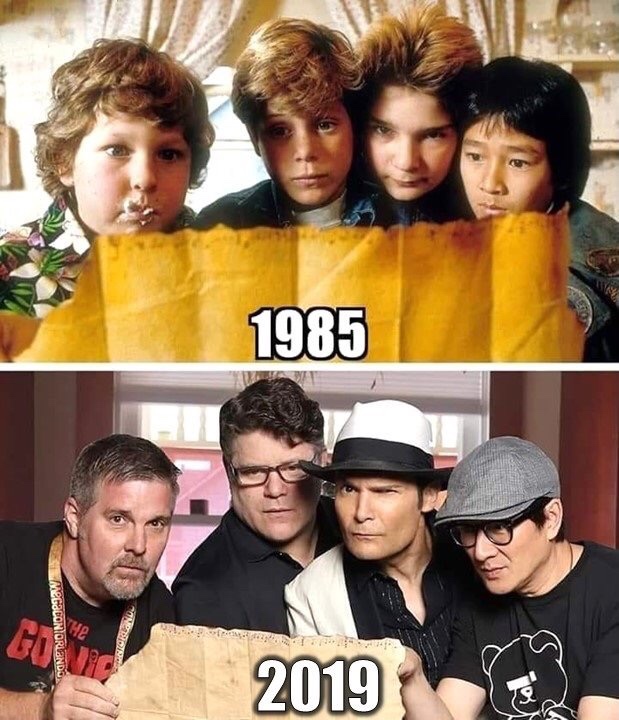The Goonies - 1985 and 2019
The Goonies, Then and Now
In order, left to right:
Chunk, Jeff Cohen, is an entertainment attorney in LA.
Mikey Walsh, Sean Astin, was a featured player in Stranger Things Season 2 and a tiny trilogy called Lord of the Rings.
Mouth, Corey Feldman, grew up to be a teen idol in the 80’s. He continues his career as a singer and songwriter.
Data, Jonathan Key Huy Quan, also recognizable from Indiana Jones and the Temple of Doom, works behind the scenes as a stunt coordinator and stunt rigger.
One night in 1837 a bright light beamed on a juggler in Covent Garden in London. It was the first use of a Limelight - an intense white beam produced by heating a piece of lime (Calcium Oxide) in a flame burning oxygen and hydrogen.
First discovered in the 1820’s by Goldsworthy Gurney, and demonstrated by Michael Faraday, the application of the light was brought to land surveying by Sir Thomas Drummond. By 1856 limelights were used at Fort Sumter at the beginning of the Civil War, and during the night construction of the Brooklyn Bridge. The first theatrical installation was put to use in London's Princesses Theater.
Operators would sit on bladders of oxygen and shift their weight to control the pressure. Not unlike a bagpipe of light? Not surprisingly, accidents were common. London’s Drury Lane Theater burnt to the ground after a bag burst.
Actors on stage, in the center of the beam were literally ‘in the limelight,’ however the turn of the phrase outside of the theater really caught on around the turn of the century.
Because the light was so intense, and because (reportedly) the light had a slight greenish hue, actors would get ready and rest in a room painted green. This was to allow the actors to adjust their eyes. It’s been said this is the origin of the term ‘green room.’ Although other sources say that ‘green’ is the area of grass where actors would wait to go on stage, the term is still used for the talent preparation room to this day in theater and television production.
Intermission
In a long feature length film (over 120 minutes) intermission served a break for the audience. It served another purpose: for the projectionist to change the reel! Intermissions were often accompanied with the film's score - or a song score for a musical.
Many great epics had intermissions, as well as the Drive-in theaters. “Lawrence of Arabia”, “The Sound of Music”, even “It’s a Mad Mad Mad Mad World” had an intermission.
In today's theater going experience, the intermission seems to be from a by-gone era, as theater owners wish to show a film as many times as possible during the day. I would like to add a few pennies to the conversation and suggest that sweeping enormous epics that require an intermission shouldn't be shied away from. In fact, "Dances with Wolves" "Wolf of Wall Street" and even "Interstellar" could have benefited with an intermission. Not just for us poor audience members who were looking for a chance to stretch our legs, run to the restroom, but also to procure more popcorn for the bucket and soft drinks, also in bucket form. Of course, if a theater is going to offer free refills of concessions, the intermission doesn't help the bottom line.
But worth mentioning, if theater operators are concerned with audiences taking their movie consumption in living rooms, an intermission could give folks a familiar 'pause' - just like at home.



